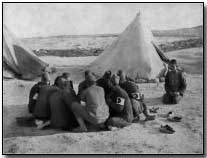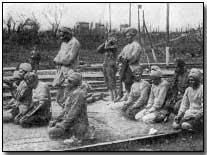Battles - The Battle of Dujaila, 1916
 The failure of General Aylmer's
latest attempt - on 21 January 1916 at
Hanna - to relieve the
besieged British force
at Kut-al-Amara - resulted in muted trench warfare throughout the month of
February as the flooding season approached.
The failure of General Aylmer's
latest attempt - on 21 January 1916 at
Hanna - to relieve the
besieged British force
at Kut-al-Amara - resulted in muted trench warfare throughout the month of
February as the flooding season approached.
Although having received reinforcements originally intended for the Western Front, Aylmer remained pessimistic about his chances of successfully relieving Sir Charles Townshend and his beleaguered 10,000 men at Kut. With the latest setback at the Hanna Defile he had advocated calling off the relief operation. However incoming regional Commander-in-Chief Sir Percival Lake was clear in his determination that Aylmer should try once again.
Aylmer therefore devised a plan whereby his force would cross the Tigris for a straightforward attack upon the Turk-held Dujaila Redoubt, at the extreme outer edge of Es Sinn, which held some 25,000 experienced troops, many of whom had fought at Gallipoli as well as along the Tigris.
Aylmer was nevertheless keen to await further reinforcement from Gallipoli. He was however over-ruled by Lake, who was wary of delaying while the floods increased in strength, and instructed to launch an attack no later than 15 March 1916.
 Thus
Aylmer ordered the bulk of his two divisions - approximately 35,000 men and 62
guns - to march overnight preparatory to storming Dujaila Redoubt while 6,500
were left behind in front of Hanna.
Thus
Aylmer ordered the bulk of his two divisions - approximately 35,000 men and 62
guns - to march overnight preparatory to storming Dujaila Redoubt while 6,500
were left behind in front of Hanna.
Meanwhile Townshend was to separately attack Turk forces from behind.
Originally scheduled to begin on 6 March the attack was postponed until 8 March on account of heavy rainfall. General Kemball led the main advance at 10am; but by noon he was stopped around 700 metres short of the Redoubt.
General Keary, separately adhering to Aylmer's specified timetable, followed up with a secondary attack but missed a clear opportunity to pierce weakened areas of the Turkish line. Townshend himself decided to call off his own planned attack from Kut once he determined the failure of the morning's operation.
Thereafter the attack dwindled with the consequence that British forces shortly afterwards returned to their starting positions having suffered a further 3,500 casualties (set against 1,200 Turkish losses).
In the wake of this latest dismal failure on the part of the relieving force Aylmer was recalled and replaced by the unpopular George Gorringe on 12 March. Recognition was finally dawning among the British high command of the improbability of ultimate success in relieving Kut.
One final effort was nevertheless attempted, at the First Battle of Kut the following month. With its failure the fate of the garrison at Kut was sealed.
Click here to view a map charting operations in Mesopotamia through to 1917.
Photographs courtesy of Photos of the Great War website
"Harry Tate" was the nickname given by British pilots to the R.E.8 aircraft
- Did you know?
